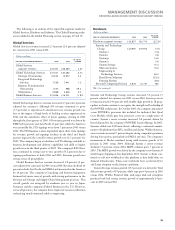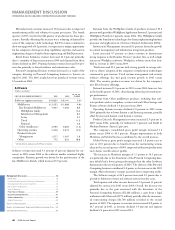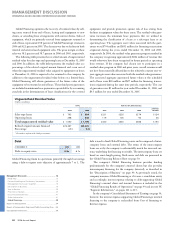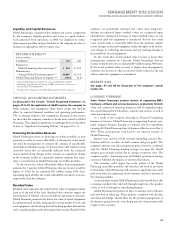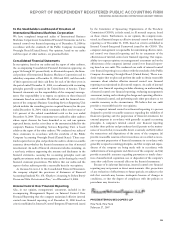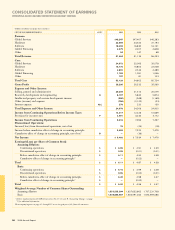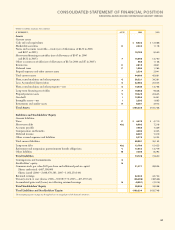IBM 2006 Annual Report Download - page 49
Download and view the complete annual report
Please find page 49 of the 2006 IBM annual report below. You can navigate through the pages in the report by either clicking on the pages listed below, or by using the keyword search tool below to find specific information within the annual report. To the extent that the provision for income taxes increases/decreases
by 1 percent of Income from continuing operations before income
taxes, consolidated Income from continuing operations would have
declined/improved by $133 million in 2006.
Valuation of Assets and Reporting Units
The application of business combination and impairment accounting
requires the use of significant estimates and assumptions. The pur-
chase method of accounting for business combinations requires the
company estimate the fair value of assets acquired and liabilities
assumed to properly allocate purchase price consideration between
assets that are depreciated and amortized from goodwill. Impairment
testing for assets, other than goodwill, requires the allocation of cash
flows to those assets or group of assets and if required, an estimate of
fair value for the assets or group of assets. Impairment testing for
goodwill requires the company assign assets and liabilities to report-
ing units along with estimating future cash flows for those reporting
units based on assumptions of future events.
The company’s estimates are based upon assumptions believed to
be reasonable, but which are inherently uncertain and unpredictable.
When appropriate, the company engages independent third-party
appraisal firms to assist in determining the fair values of assets and
reporting units. These valuations, whether performed by the com-
pany or an independent third party, require the use of management’s
assumptions, which would not reflect unanticipated events and cir-
cumstances that may occur.
Restructuring Actions
The company has executed, and may continue to execute, restructur-
ing actions which require management to utilize significant estimates
related to expenses for severance and other employee separation
costs, realizable values of assets made redundant or obsolete, lease
cancellation and other exit costs. If the actual amounts differ from the
company’s estimates, the amount of restructuring charges could be
materially impacted. See note R, “2005 Actions,” on pages 93 and 94
for a description of restructuring actions.
Loss Contingencies
The company is currently involved in various claims and legal pro-
ceedings. Quarterly, the company reviews the status of each significant
matter and assesses its potential financial exposure. If the potential loss
from any claim or legal proceeding is considered probable and the
amount can be reasonably estimated, the company accrues a liability
for the estimated loss. Significant judgment is required in both the
determination of probability and the determination as to whether an
exposure is reasonably estimable. Because of uncertainties related to
these matters, accruals are based only on the best information avail-
able at the time. As additional information becomes available, the
company reassesses the potential liability related to its pending claims
and litigation and may revise its estimates. Such revisions in the esti-
mates of the potential liabilities could have a material impact on the
company’s results of operations and financial position.
MANAGEMENT DISCUSSION
INTERNATIONAL BUSINESS MACHIN ES CORPORATION AND SUBSI DIARY COMPANIES
47
CURRENCY RATE FLUCTUATIONS
Changes in the relative values of non-U.S. currencies to the U.S.
dollar affect the company’s results. At December 31, 2006, currency
changes resulted in assets and liabilities denominated in local curren-
cies being translated into more dollars than at year-end 2005. The
company uses a variety of financial hedging instruments to limit spe-
cific currency risks related to financing transactions and other foreign
currency-based transactions. Further discussion of currency and
hedging appears in note L, “Derivatives and Hedging Transactions,”
on pages 83 through 86.
The company earned approximately 45 percent of its net income
in currencies other than the U.S. dollar. The company also maintains
hedging programs to limit the volatility of currency impacts on the
company’s financial results. These hedging programs limit the impact
of currency changes on the company’s financial results but do not
eliminate them. In addition to the translation of earnings and the
company’s hedging programs, the impact of currency changes also
may affect the company’s pricing and sourcing actions. For example,
the company may procure components and supplies in multiple func-
tional currencies and sell products and services in other currencies.
Therefore, it is impractical to quantify the impact of currency on
these transactions and on consolidated net income. Generally, the
company believes that extended periods of dollar weakness are positive
for net income and extended periods of dollar strength are negative,
although the precise impact is difficult to assess.
For non-U.S. subsidiaries and branches that operate in U.S. dollars
or whose economic environment is highly inflationary, translation
adjustments are reflected in results of operations, as required by SFAS
No. 52, “Foreign Currency Translation.” Generally, the company
manages currency risk in these entities by linking prices and contracts
to U.S. dollars and by entering into foreign currency hedge contracts.
MARKET RISK
In the normal course of business, the financial position of the com-
pany is routinely subject to a variety of risks. In addition to the
market risk associated with interest rate and currency movements on
outstanding debt and non-U.S. dollar denominated assets and liabili-
ties, other examples of risk include collectibility of accounts receivable
and recoverability of residual values on leased assets.
The company regularly assesses these risks and has established
policies and business practices to protect against the adverse effects of
these and other potential exposures. As a result, the company does not
anticipate any material losses from these risks.
The company’s debt, in support of the Global Financing business
and the geographic breadth of the company’s operations, contains an
element of market risk from changes in interest and currency rates.
The company manages this risk, in part, through the use of a variety
of financial instruments including derivatives, as explained in note L,
“Derivatives and Hedging Transactions,” on pages 83 through 86.
To meet disclosure requirements, the company performs a sensitivity
analysis to determine the effects that market risk exposures may have on
the fair values of the company’s debt and other financial instruments.
Black
MAC
CG10




